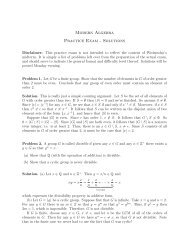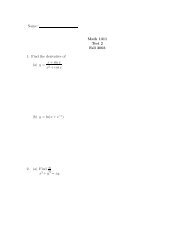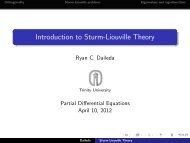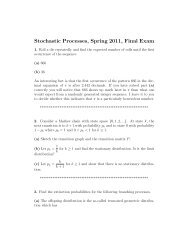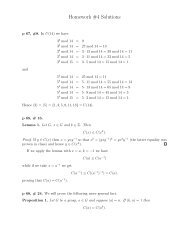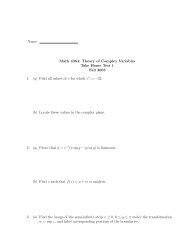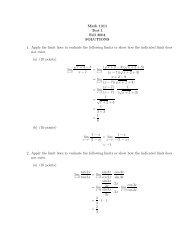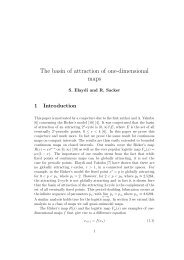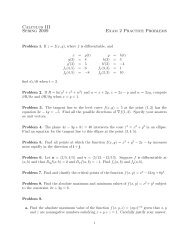Real Analysis Fall 2004 Take Home Test 1 SOLUTIONS 1. Use the ...
Real Analysis Fall 2004 Take Home Test 1 SOLUTIONS 1. Use the ...
Real Analysis Fall 2004 Take Home Test 1 SOLUTIONS 1. Use the ...
You also want an ePaper? Increase the reach of your titles
YUMPU automatically turns print PDFs into web optimized ePapers that Google loves.
For any given ε > 0 <strong>the</strong>re exists N 2 > 0 such that for n > N 2 , |x n − L| < 2ε<br />
L . 2<br />
Let N = max{N 1 , N 2 }. Then for n > N,<br />
1<br />
Thus lim<br />
n→∞ x n<br />
= L.<br />
1<br />
∣ − 1 x n L∣ = |x n − L|<br />
|x n ||L|<br />
≤ |x n − L|<br />
L 2 / 2<br />
< 2ε/L2<br />
L 2 / 2<br />
= ε.<br />
1<br />
3. Let x n+1 = , x 1 > 0. Prove that <strong>the</strong> sequence {x n } converges and <strong>the</strong>n compute<br />
3 + x n<br />
<strong>the</strong> limit of <strong>the</strong> sequence.<br />
1<br />
< 1 3 + x n 3<br />
= 3<br />
10 for all n ≥ <strong>1.</strong> Hence 3 10 < x n < 1 3<br />
First Proof (My Preference). Since x 1 > 0, x n+1 =<br />
x n+1 = 1<br />
3 + x n<br />
< 1<br />
3 + 1 3<br />
1<br />
(b) If lim x n = L exists, <strong>the</strong>n L = lim x n+1 = lim =<br />
n→∞ n→∞ n→∞ 3 + x n<br />
Thus<br />
L = −3 + √ 13<br />
.<br />
2<br />
(a) If x 1 > L, <strong>the</strong>n x 2 =<br />
1<br />
3 + L<br />
for all n ≥ <strong>1.</strong> Moreover,<br />
for all n > <strong>1.</strong><br />
1<br />
lim (3 + x n) = 1<br />
3 + L<br />
n→∞<br />
= L. (1)<br />
L 2 + 3L − 1 = 0. (2)<br />
1<br />
< 1<br />
3 + x 1 3 + L = L from (1). More generally, if x 2n−1 > L,<br />
1<br />
<strong>the</strong>n x 2n = < 1<br />
3 + x 2n−1 3 + L = L. On <strong>the</strong> o<strong>the</strong>r hand, if x 1 < L, <strong>the</strong>n x 2n−1 < L<br />
and x 2n > L. Without loss of generality, assume x 1 > L. Define <strong>the</strong> sequence {s n }<br />
as s n = |x n − L|. Then claim that s n+1 < s n for all n ≥ <strong>1.</strong> If not, <strong>the</strong>n s n+1<br />
≥ <strong>1.</strong><br />
s n<br />
Assume n = 2k. Then<br />
s 2k+1<br />
s 2k<br />
= x 2k+1 − L<br />
L − x 2k<br />
=<br />
1<br />
3+x 2k<br />
− L<br />
≥ 1<br />
L − x 2k<br />
1 − 3L − Lx 2k ≥ 3L − 3x 2k + Lx 2k − x 2 2k<br />
(x 2 2k − 2Lx 2k + L 2 ) − L 2 − 6L + 3x 2k + 1 ≥ 0<br />
(x 2k − L) 2 − 1 − 3L + 3x 2k + 1 ≥ 0 (using (2))<br />
(x 2k − L)[x 2k − L + 3] ≥ 0.



